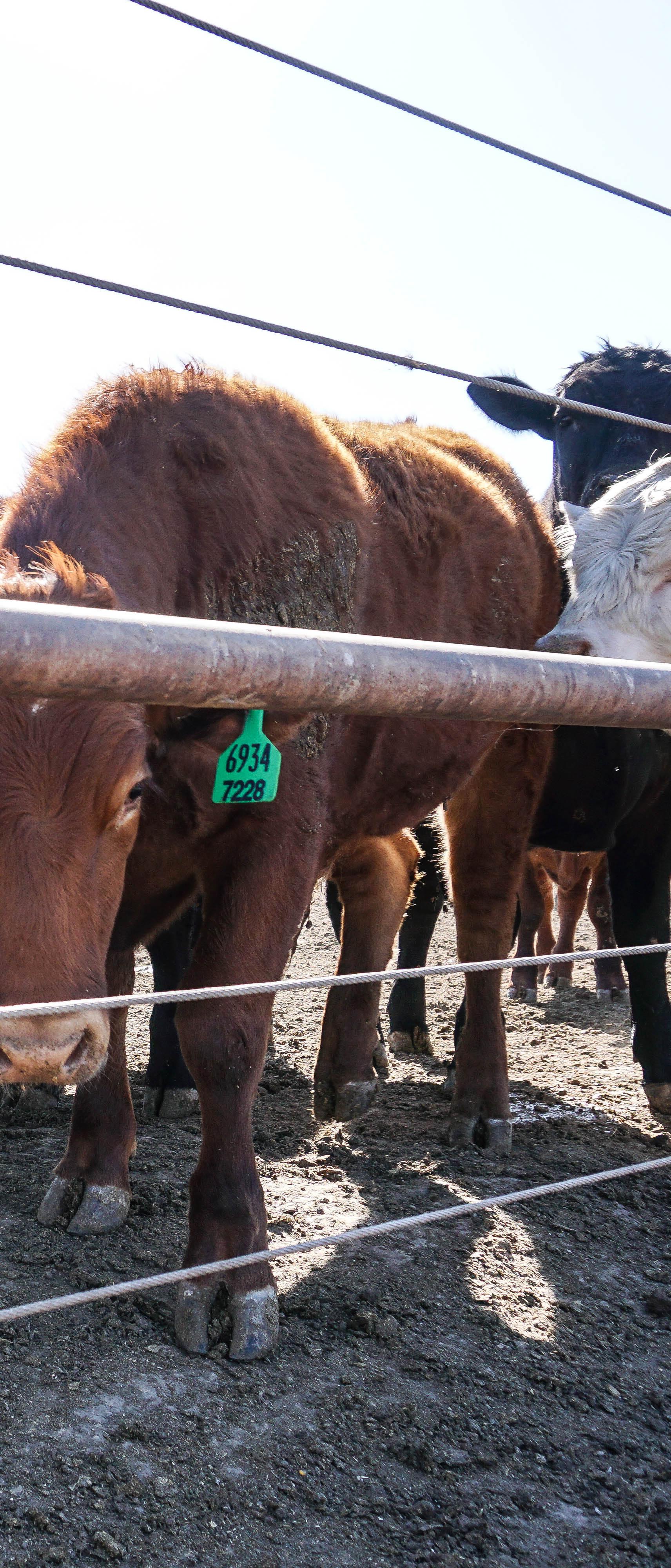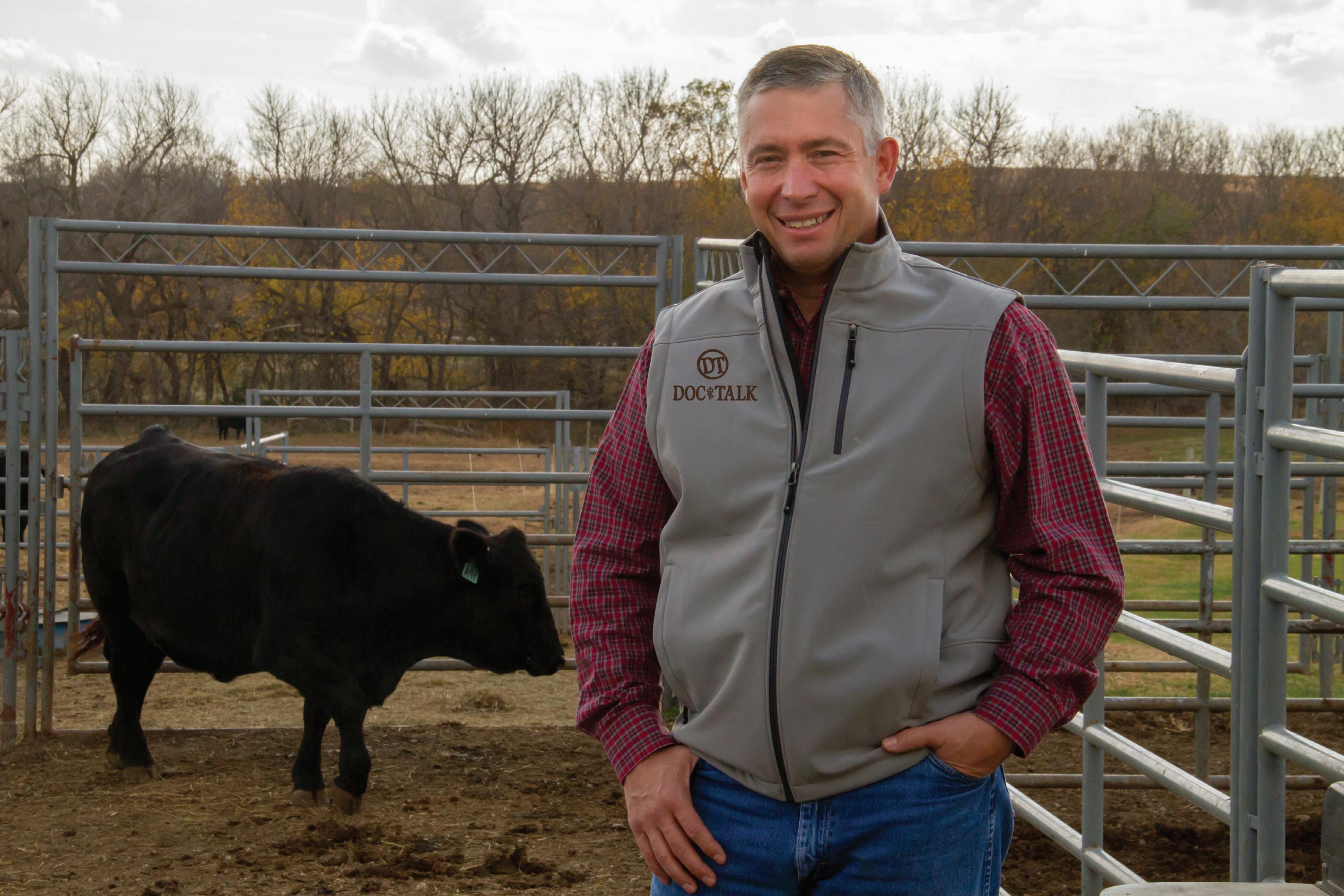
4 minute read
Everything in MOderation
By: Justin Axman, M.S. Hi Plains Feed, LLC
How can you tell the difference between your barnyard cats, dogs, and beef cattle from the inside out? Well, that can get rather technical, but I am certain the largest concern over morning coffee is not how you are going to feed your cats and dogs during drought-stricken times. We can meet their nutrient requirements with a bag of pet food from the local feed store, whereas grazing and feeding beef cattle warrants a little more strategy.
Pasture and cattle management are important factors to consider to maintain nutrient dense and high integrity pasture. Unfavorable weather and overgrazing are variables that can quickly deplete pastures of nutritional value. For most areas of the Southern Plains, current dry conditions continue to persist. Therefore, depending on the goals of your beef cow breeding program, this can lead to the necessity for alternative feedstuffs to stretch an already tight hay and pasture supply, or dry-lotting and completely replacing with a total mixed ration (TMR). Turning cattle out this spring on growing grass that has not received ample moisture can promote depletion of root reserves which will hinder growth throughout the growing season and decrease longterm pasture health. One way to assess whether alternatives will be necessary is to properly assess forage demand (animal size, length of grazing period, and number of animals grazing) and forage availability (lb/acre) to calculate stocking rate. When changes are made to your current program, there are several nutritional items to keep in mind to optimize reproductive performance. Let’s be nutritionally mindful and focus on the following: dietary crude protein (CP) concentration, inorganic sulfur content, and the calcium to phosphorus (Ca:P) ratio.
The nutrient requirements of beef cattle have been outlined by the National Research Council (NRC) based on years of research encompassing the biological processes of ruminants. These recommendations have guided nutritionists and consulting professionals to develop specific feeding programs for beef cattle. However, deviations from these recommendations can potentially lead to unintended performance or adverse effects. Beef cow and post-pubertal heifer nutrition prior to and following breeding can affect embryonic development and survival. When providing supplemental feed such as distillers grains products, be aware of nutrient content and protein availability. For example, when supplementing dried distillers grains (DDG; 27.5% CP as fed, 92.5% DM) while grazing native pasture in suboptimal condition, a good rule of thumb is to target 0.50 to 1.00 lb. of CP per animal daily. This will require a feeding rate of 1.82 to 3.64 lb DDG per animal daily. However, certain conditions and stages of production may warrant deviations from this range but it is a good reference point to help stray from excessive supplementation. Additionally, if your alternative is to feed a TMR, be sure that your dietary crude protein concentration is in line with NRC recommendations. For example, you are feeding a TMR to cows weighing 1300 lbs. in late gestation and targeting dry matter intakes at 2.0% of bodyweight (26 lb.) with an approximate requirement of 7.9% CP (% diet DM). Upon viewing your bunk sample analysis, the crude protein content reads 14.0% of diet dry matter. This level would be acceptable for feeding certain stages of growing/finishing cattle or limit-feeding; however, in theory this would equate to supplying approximately 3.64 lb of crude protein which well exceeds an approximate requirement of 2.0 lb daily for this stage of production. This initially may seem harmless since milk production and dry matter intake are stimulated by increased intake of dietary protein. However, when exceeding requirement, dietary protein that is degraded in the rumen can ultimately lead to decreased fertility. Technically speaking, when blood urea levels increase from excess dietary protein intake, this has the potential to negatively affect reproductive function and physiology by altering uterine pH. In addition, this can lead to decreased fertility by lowering plasma progesterone concentrations, which is a hormone involved in maintaining pregnancy. Furthermore, by altering secretions of the reproductive tract (progesterone and prostaglandin) and elevating levels of plasma urea nitrogen, we can create an environment with the potential to decrease fertility.
Let’s continue with the distiller’s grains example, which is a commonly used feedstuff as a supplement in pasture programs or included in a TMR in dry-lot situations and contains an appreciable amount of sulfur. Sulfur is necessary for synthesis of sulfur-containing amino acids, as well as thiamin and biotin. Sulfur levels can be greatly variable across distiller’s grains sources and tend to average around 0.7% (± 0.4%) on a dry matter basis. However, excess intake can lead to unintended complications which is why it is prudent not to forget about levels of sulfur in various feedstuffs and drinking water.
How can sulfur be a detrimental factor to reproductive performance? Of the trace minerals that are supplied naturally or by producers, there are a number of antagonisms that take place. One such antagonism involves sulfur, a copper antagonist, binding a portion of available copper and rendering it unavailable for absorption. This can lead to what is known as a secondary mineral deficiency, which is caused by the consumption of one or more mineral antagonists. A common rule of thumb is if dietary sulfur concentrations are at or above 0.25% of diet dry matter, this is adequate to promote antagonism. Copper, behind phosphorus, is typically considered the second most limiting mineral in pasture cattle programs. Copper plays pivotal roles in reproductive, enzyme, hormone, and immune systems. One of the major effects of copper deficiency is decreased enzyme system productivity. In turn, this can affect reproduction by decreasing overall pregnancy rates, altered embryonic survival (especially in embryo transfer programs), altered or delayed estrous cycles, and retained placentas.
Lastly, calcium is the most abundant mineral in the body and is a major constituent in most commercial vitamin and mineral supplements. Just to name a few, calcium plays a large role in milk production, nerve function, muscle contraction, and cell permeability. Harvested forages, mature pastures, small grain forages, and grains can be deficient in calcium. On the contrary, phosphorus can be rather abundant in several commonly fed co-products, such as distillers grains products and wheat middlings (0.5% to over 1% phosphorus). When phosphorus intake surpasses calcium intake, calcium absorption is decreased and causes calcium to be mobilized out of the bone. Therefore, it is prudent to keep the dietary Ca:P ratio in check to decrease your chances of hypocalcemia syndrome (also known as milk fever or the formal title parturient paresis). High risk periods for beef cattle occur most commonly in older animals during the last stages of gestation while mobilizing large portions of calcium for colostrum and fetal bone development. Symptoms include muscular weakness, incoordination, coma, and ultimately death. As a point of reference, target a Ca:P ratio range between 1.5:1 and 3:1.

The bottom line is there are many variables worth considering when building and complementing your nutrition program. To develop the most accurate goals, be sure to accurately assess your short and potential long-term circumstances, perform the necessary research for your specific operation, and consult with your nutritionist.











